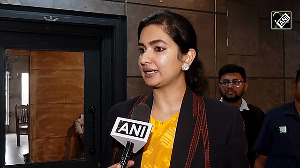As the current year comes to an end, and I reflect on some of the developments during these last 12 months, I have a sense of anticipation and excitement for the coming 12.
One of the most interesting developments of 2004 has been the resounding affirmation that those who dare to dream big end up winning big.
L N Mittal becoming the world's leading producer of steel and Reliance Industries becoming the world's leading producer of polyester fibre are truly incredible success stories.
If we also take into consideration the audacity of Lenovo of China, having started with no more than $20,000 in capital just 20 years ago, to pay almost $1.7 billion to acquire the PC & notebook business of IBM and thereby catapulting itself into becoming the world's third-largest PC maker, there is a learning and an important message for other Indian entrepreneurs -- to think big and act big!
Hopefully, in 2005, many other Indian icons of our current era shall make a very serious effort to emulate such peers.
At a more micro level, I can spot many innovations and encouraging developments across each of the "Four Ps" (to use Philip Kotler's terminology).
Some of the most promising new products from my perspective have been the successful launch and stabilisation of the budget airline Air Deccan; the new retail format from Kishore Biyani called Central (currently in operation in Bangalore and Hyderabad); the chain of budget business hotels named IndiOne from the Indian Hotels (Tata Group); and the new hypermarket offer from Trent (promoters of Westside) named Star India Bazaar.
Air Deccan has been an idea that had been waiting to come to India, and it was surprising that the lead was taken by a till then unknown entrepreneur: Captain Gopinath, and not from either the promoters of Jet Airways or one of the larger Indian business houses.
Air Deccan's successful debut is now likely to be emulated by a number of other start-ups including those from Nusli Wadia and Vijay Mallya and in the process, the entire personal travel market in India shall undergo a paradigm shift.
Central's seamless shopping mall concept provides a higher-quality shopping experience for the consumers, and a very interesting business model both for Mr Biyani as well as the tenants/retailers operating under Central's roof.
With an exponential increase in business activity, and accordingly, business travel, the need for a very high-standard and functional-value hotel was very visible.
IndiOne has already set a very high value-performance standard. Lastly, while hypermarkets have already made their presence felt in parts of India through brands such as Giant/Spencer and Big Bazaar, Trent's Star India Bazaar in Ahmedabad has truly raised the bar very high even by international standards.
Most certainly, Star India Bazaar would be given tough competition by the incumbents as well as the new entrants, and in the process, almost all consumers in India shall benefit tremendously.
On the "price" front, the most interesting development has been decompression aggressively introduced by P&G. Till then, it almost seemed that the existing leader --HLL -- and other players had reconciled themselves to their current market positions and were unable or unwilling to take any bold step to stimulate demand through aggressive pricing strategies.
As data now start to trickle in, P&G's pricing war seems to have finally catalysed more encouraging volume growth in the FMCG sector, auguring well not only for the consumers but also for the leading players in this sector as well.
On the "place" or channel front, 2004 has finally seen a very rapid scaling up of modern retail in India.
Current leaders such as Shoppers Stop, Lifestyle, Westside, Pantaloon/Big Bazaar, and Piramyd have finally started an aggressive expansion across India, and millions of square feet of additional retail space is likely to be taken up by these modern format retailers, fundamentally altering the buying behaviour of hundreds of millions of Indians as far as shopping channels are concerned.
The retail space itself finally started to look more enticing, with some really good shopping malls such as Inorbit in Mumbai and Forum at Bangalore setting standards for the hundreds likely to come up in the coming years.
On the fourth P -- "promotion" (and branding) -- I can only think of two glaring failures and the lessons from them.
The BJP's India Shining campaign boomeranged shockingly and miserably, thereby bringing attention back on some fundamental truths: brilliant advertising can create awareness but cannot sell bad or inadequate products.
A corollary from this flop campaign was also that to succeed in India, you need to focus on the "masses" and not the so-called "class" (especially the urban SEC A's, so to say).
Bangalore's dramatic fall from grace within a span of 12 months, on account of the incredulous apathy of Karnataka's political leadership to invest in keeping the brand fresh and aspirational (by investing in sustained improvements in its infrastructure and business climate), only shows that how rapidly the world can change today, and with that, how much more challenging it is for business (and political) leaders to stay competitive.
What we can look forward to? I believe that the year 2005 shall be a turning point for China, in the sense that finally, Made in China could well become not only acceptable but even aspirational, the same way Made in Japan went 30 years ago.
2005 could also be the beginning of a turning point for India with "Been to India; Doing Business with India" the "in" thing to say from a westerner's perspective. With this, I would like to bid a warm good bye to 2004, and raise a very optimistic toast to 2005!





